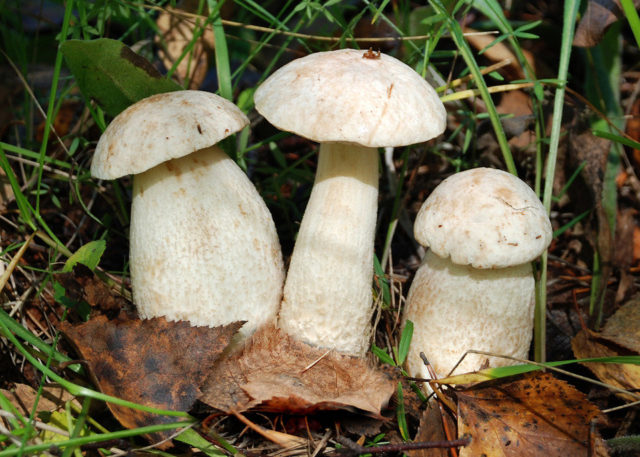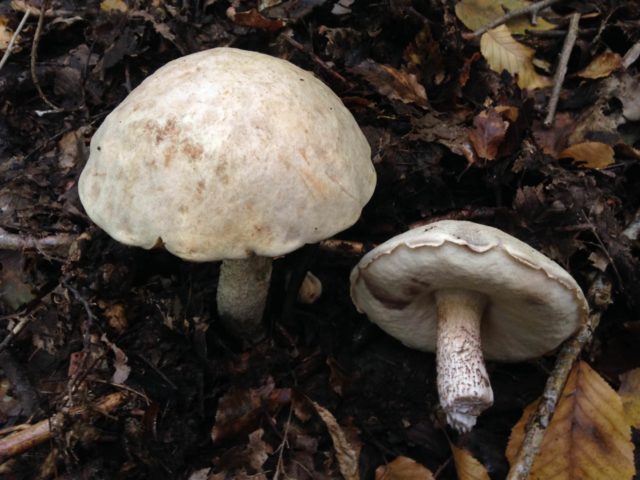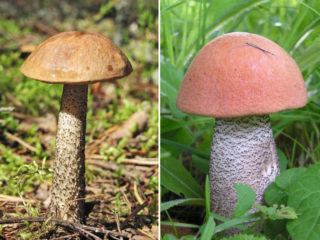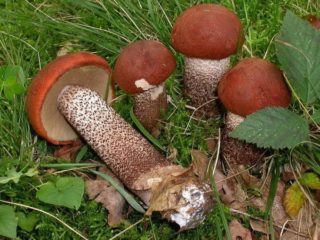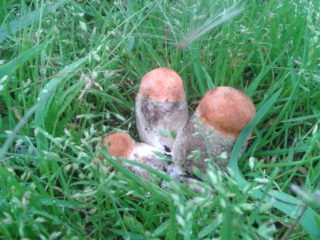Content
White boletus is an edible mushroom that is often found in Russia, North America and European countries. It is appreciated for its good taste and ease of preparation. The collection season begins in summer and continues until autumn. The boletus has its own characteristics, by which it is distinguished from its counterparts.
Are there white boletuses?
Boletuses are different types of mushrooms that belong to the genus Leccinum. They are distinguished by an orange cap and dense flesh. The leg is usually thick, widening towards the base.When cut, the flesh acquires a bluish tint.
Most mushroom pickers are familiar with the red boletus. This is a mushroom with a cap up to 15 cm in size, hemispherical or convex in shape. The color is red, orange or brownish. The leg is up to 5 cm thick and reaches 15 cm in length. The flesh is dense, elastic, and white. After cutting it becomes bluish and even black. The variety is valued for its taste. It is used for frying, boiling, pickling and salting.
White boletuses are often found in forests. Their cap is not brightly colored. Its color remains milky white, as does the leg. These mushrooms have a good taste and are suitable for consumption. They are also popularly known as obabki.
What porcini mushrooms look like
According to the photo and description, the white boletus is large in size. The cap is fleshy, its size reaches 25 cm. On average, its parameters do not exceed 5-15 cm. The surface has a white, pink, brown or grayish tint. The top of the cap is dry and feels like felt.
The leg is high, club-shaped. It has a thickening at the bottom. The color is white, the surface is scaly. As they grow, the scales become brown or gray. The spores are ocher in color.
On the reverse side, the cap consists of small white pores. As the fruiting body grows, they acquire a brown or gray undertone. The pulp of the white variety is dense. The color of the leg near the ground is greenish-blue. At the cut site, the flesh becomes blue, almost black.
Where do white aspens grow?
White boletuses are found in the temperate climate zone. They are collected in coniferous, deciduous and mixed forests. Fruiting bodies form mycosis with birch, aspen, spruce, and fir trees.They occur in areas with high humidity. This includes places near ponds and streams, ravines, and lowlands. The white variety grows in the soil, on stumps, and in dead wood.
The rarity of white boletus is associated with anthropogenic factors. As a result of human activity, the habitat of fungi is changing. First of all, the disappearance of boletuses is due to deforestation.
White boletus grows in the North-Western region, the Moscow region, the Republic of Chuvashia, Mari El, Komi. In Siberia, it is collected near Lake Baikal and in more northern regions. In Europe it is found in Belarus, Latvia, and Estonia. It is also found in the forests of North America.
The white variety grows solitarily, sometimes forming small groups. In dry summers, fruiting bodies appear in damp places where moisture constantly accumulates. When picking mushrooms, check clearings and areas near forest roads and trails.
Fruiting lasts from June to mid-autumn. Usually there are 3 waves of growth. The first fruiting bodies appear at the end of June. During this period, single specimens appear. The second wave is more abundant, its peak occurs in mid-summer. Individual mushrooms can be collected in September and October, when the third layer passes.
Is it possible to eat porcini mushrooms?
The white-capped boletus is edible and poses no threat to humans. The pulp is rich in fiber, vitamins and amino acids, which are well absorbed by the body. White aspen belongs to the mushrooms of the second food category.This includes edible varieties with good taste. In terms of nutritional quality, they are second only to porcini mushrooms, milk mushrooms and chanterelles.
Boletuses help strengthen the immune system, which is especially important when recovering from illness. The substances contained in the pulp have a positive effect on the composition of the blood and support the functioning of the heart. Regular presence of this species in the diet helps remove waste and toxins from the body.
Before use, boletus is soaked in water and then boiled. After processing, toxins are released from the pulp. The product is not used in its raw form. The resulting mass is used for further cooking or frozen for the winter.
Various homemade preparations are obtained from the white variety. Marinated boletus mushrooms retain their good taste and serve as an excellent appetizer. Fruit bodies are also pickled hot or cold.
How to distinguish false white boletuses
White boletuses have a false twin. This is a mushroom that is similar to them in appearance. This includes the gall fungus, which is also called false boletus. This name is associated with the bitter taste of its pulp, which only intensifies during heat treatment.
The gall mushroom has a cap measuring from 4 to 15 cm. Its shape is hemispherical and becomes prostrate over time. The surface is dry, velvety, and becomes sticky after rains. The color is yellow with a brown, gray or brown undertone. The leg is from 3 to 13 cm high. Its shape is cylindrical, often there is a thickening at the base.
False boletus is distinguished from the real one by the color of the pulp. In the gall fungus it has a pink tint. Also, the false double has a yellow or pink mesh on its leg. It is absent in the white species. Also pay attention to the color of the cap. The gall fungus has a more pronounced color.
Boletuses have characteristic features, so they are difficult to confuse with poisonous mushrooms. Varieties may differ in cap size and color. However, they are all edible and do not pose a threat to human health.
Rules for collecting white-capped boletuses
It is best to go to the forest in the morning, after rain or fog. Fruiting bodies grow actively in warmth and high humidity. The leg is cut off with a sharp knife. No need to tear them or break them off. This can damage the mycelium.
To collect mushrooms, choose places located far from roads and industrial enterprises. Such objects pollute the environment, and fruiting bodies absorb harmful substances. White boletuses are placed in wide baskets. Leave free space between them so that the mass does not wrinkle or heat up.
Eating white boletus
Boletus mushrooms are processed before use. The mass is placed in clean water, dirt, leaves and other forest debris are removed. Then the water is drained and the fruiting bodies are cut into pieces. They are placed in an enamel container with water and placed on the stove. Mushrooms are simmered over low heat for an hour.
The boiled mass can be fried, added to soups and side dishes.Their mushrooms are used as fillings for pies and other baked goods. The cooked product is stored in the refrigerator.
The easiest way is to pickle white boletus for the winter. First, the fruiting bodies are boiled for 10 minutes over low heat. Then prepare the marinade: add 1 tbsp to 1 liter of water. l. sugar and 1.5 tbsp. l. salt. Mix the ingredients in a saucepan, place on the stove and wait until it boils. Then the mushrooms are poured into the marinade, garlic, bay leaf, and peppercorns are added to taste. Cook for 20 minutes over low heat, add vinegar essence and split into jars.
Salted boletus mushrooms are also easy to prepare. First they are boiled in salt water for 35 minutes. Then salt, mushrooms, and spices to taste are placed in the jar. The components are filled with water and transferred to a cold place for salting.
In order for boletus boletuses to provide health benefits, their consumption must be limited. The daily norm should not exceed 150 g. If you have kidney, liver or stomach diseases, first consult a doctor. Children and women during pregnancy and breastfeeding should not take it.
Interesting facts about white boletuses
3 interesting facts about boletuses:
- The mushrooms got their name not only because they are often found under aspen trees. This is due to the color of the caps, which resembles the color of fading leaves.
- In North America, white boletus is an important ingredient in the national dish. It is served at the wedding table, with paprika, cloves and spices added.
- Boletus broth is very healthy and tasty. In terms of nutritional value, it is not inferior to a similar meat-based dish.
Conclusion
White boletus is a healthy and tasty mushroom that is used for canning for the winter.They go to damp areas of the forest to pick mushrooms. After collection, the mushroom mass is subjected to heat treatment. White boletus is suitable for preparing first and second courses, fillings for baked goods.
